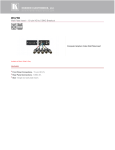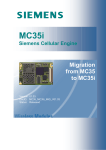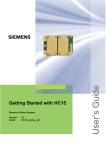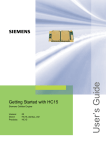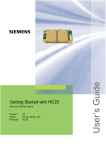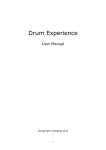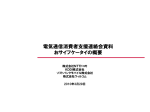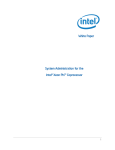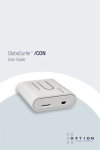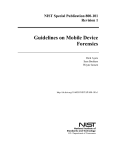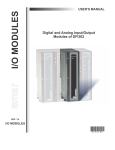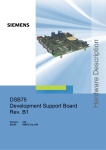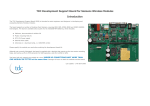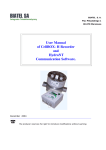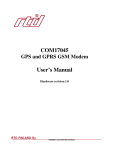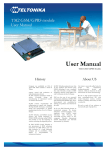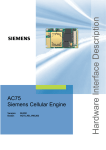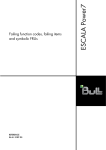Download User Guide - Wireless
Transcript
DSB-Mini User Guide
Version:
DocId:
03
dsb-mini_ug_v03
User Guide
c
c
DSB-Mini User Guide
User Guide:
DSB-Mini User Guide
Version:
03
Date:
2013-03-12
DocId:
dsb-mini_ug_v03
Status
Confidential / Released
GENERAL NOTE
THE USE OF THE PRODUCT INCLUDING THE SOFTWARE AND DOCUMENTATION (THE "PRODUCT") IS SUBJECT TO THE RELEASE NOTE PROVIDED TOGETHER WITH PRODUCT. IN ANY
EVENT THE PROVISIONS OF THE RELEASE NOTE SHALL PREVAIL. THIS DOCUMENT CONTAINS INFORMATION ON CINTERION PRODUCTS. THE SPECIFICATIONS IN THIS DOCUMENT
ARE SUBJECT TO CHANGE AT CINTERION'S DISCRETION. CINTERION WIRELESS MODULES
GMBH GRANTS A NON-EXCLUSIVE RIGHT TO USE THE PRODUCT. THE RECIPIENT SHALL NOT
TRANSFER, COPY, MODIFY, TRANSLATE, REVERSE ENGINEER, CREATE DERIVATIVE WORKS;
DISASSEMBLE OR DECOMPILE THE PRODUCT OR OTHERWISE USE THE PRODUCT EXCEPT
AS SPECIFICALLY AUTHORIZED. THE PRODUCT AND THIS DOCUMENT ARE PROVIDED ON AN
"AS IS" BASIS ONLY AND MAY CONTAIN DEFICIENCIES OR INADEQUACIES. TO THE MAXIMUM
EXTENT PERMITTED BY APPLICABLE LAW, CINTERION WIRELESS MODULES GMBH DISCLAIMS ALL WARRANTIES AND LIABILITIES. THE RECIPIENT UNDERTAKES FOR AN UNLIMITED
PERIOD OF TIME TO OBSERVE SECRECY REGARDING ANY INFORMATION AND DATA PROVIDED TO HIM IN THE CONTEXT OF THE DELIVERY OF THE PRODUCT. THIS GENERAL NOTE
SHALL BE GOVERNED AND CONSTRUED ACCORDING TO GERMAN LAW.
Copyright
Transmittal, reproduction, dissemination and/or editing of this document as well as utilization of its contents and communication thereof to others without express authorization are prohibited. Offenders will
be held liable for payment of damages. All rights created by patent grant or registration of a utility model
or design patent are reserved.
Copyright © 2013, Cinterion Wireless Modules GmbH
Trademark Notice
Microsoft and Windows are either registered trademarks or trademarks of Microsoft Corporation in the
United States and/or other countries. All other registered trademarks or trademarks mentioned in this
document are property of their respective owners.
dsb-mini_ug_v03
Confidential / Released
Page 2 of 30
2013-03-12
c
DSB-Mini User Guide
Contents
30
Contents
0
Document History ...................................................................................................... 6
1
Introduction ................................................................................................................. 7
1.1
Regulatory Compliance Information................................................................... 7
1.2
Supported Products ........................................................................................... 7
1.3
Related Documents ........................................................................................... 7
1.4
Scope of delivery ............................................................................................... 8
2
Product Concept ......................................................................................................... 9
2.1
Key Features at a Glance ................................................................................ 10
2.2
System Overview ............................................................................................. 11
3
Interface Description ................................................................................................ 12
3.1
Power Supply................................................................................................... 12
3.1.1 Power Path Switch.............................................................................. 12
3.2
Serial Communication Interfaces ..................................................................... 13
3.3
Analog Audio Interface..................................................................................... 14
3.4
SIM Interface.................................................................................................... 14
3.4.1 Automatic Dual SIM Operation ........................................................... 14
3.4.2 CCVCC Adjustment ............................................................................ 15
3.4.3 Component SIM Card Support............................................................ 15
3.5
Status LEDs ..................................................................................................... 15
3.6
Application Connectors .................................................................................... 16
3.6.1 2x40-Pin Connector for Starter Kits .................................................... 16
3.6.2 80-Pin Connector for DSB75 Module Adapters .................................. 21
3.6.3 10-Pin Digital Audio Connector........................................................... 22
3.6.4 10-Pin Connector for Starter Kit Signals ............................................. 22
3.7
Patch Field ....................................................................................................... 23
4
Appendix: Schematics and Placement ................................................................... 24
dsb-mini_ug_v03
Confidential / Released
Page 3 of 30
2013-03-12
c
DSB-Mini User Guide
Tables
30
Tables
Table 1:
Table 2:
Table 3:
Table 4:
Table 5:
Table 6:
Table 7:
Table 8:
Table 9:
Table 10:
DSB-Mini delivery package .............................................................................. 8
Key features at a glance ................................................................................ 10
Automatic dual SIM operation ........................................................................ 14
CCVCC adjustment........................................................................................ 15
Status LEDs ................................................................................................... 15
2x40 pin connector pin assignment................................................................ 16
2x40-pin connector pin description and mapping........................................... 17
80-pin connector pin assignment ................................................................... 21
10-pin digital audio connector ........................................................................ 22
10-pin connector for additional Starter Kit signals.......................................... 22
dsb-mini_ug_v03
Confidential / Released
Page 4 of 30
2013-03-12
c
DSB-Mini User Guide
Figures
30
Figures
Figure 1:
Figure 2:
Figure 3:
Figure 4:
Figure 5:
Figure 6:
Figure 7:
Figure 8:
Figure 9:
DSB-Mini overview........................................................................................... 9
DSB-Mini system overview ............................................................................ 11
Schematics, Page 1 ....................................................................................... 24
Schematics, Page 2 ....................................................................................... 25
Schematics, Page 3 ....................................................................................... 26
Schematics, Page 4 ....................................................................................... 27
Schematics, Page 5 ....................................................................................... 28
Placement, Page 1 (top) ................................................................................ 29
Placement, Page 2 (with Starter Kit mounted) ............................................... 30
dsb-mini_ug_v03
Confidential / Released
Page 5 of 30
2013-03-12
c
DSB-Mini User Guide
0 Document History
6
0
Document History
Preceding document: "DSB-Mini User Guide" Version 02
New document: "DSB-Mini User Guide" Version 03
Chapter
What is new
4
Revised pin assignment of digital audio interface in Figure 3.
Preceding document: "DSB-Mini User Guide" Version 01
New document: "DSB-Mini User Guide" Version 02
Chapter
What is new
1.1
New section Regulatory Compliance Information.
New document: "DSB-Mini User Guide" Version 01
Chapter
What is new
---
Initial document setup.
dsb-mini_ug_v03
Confidential / Released
Page 6 of 30
2013-03-12
c
DSB-Mini User Guide
1 Introduction
23
1
Introduction
The DSB-Mini is a simple and easy-to-use development support board, designed to assist system integrators in developing and evaluating products based on Cinterion Wireless Modules.
This document describes all interfaces of the DSB-Mini, provides technical specifications and
presents guidelines for connecting and operating the Cinterion modules to be evaluated.
Chapter 2 introduces the product concept, including key features and system overview, Chapter 3 describes the DSB-Mini’s interfaces in some more detail including the DSB-Mini’s connector pin assignments. The Appendix finally contains schematics and placement (see Chapter 4).
1.1
Regulatory Compliance Information
The DSB-Mini is intended for use only in a laboratory test environment. All persons handling
the DSB-Mini must be properly trained in electronics and observe good engineering practice
standards.
The DSB-Mini is a test/development platform and has not been designed to be embedded into
other products (referred as "final products").
The DSB-Mini is not intended for use as reference environment for type approval.
1.2
Supported Products
The DSB-Mini provides two 40-pin connectors to mount the Cinterion Starter Kits B60 and B80
in order to evaluate the full functionality of modules that can be connected to these Starter Kits.
Also, the DSB-Mini has an 80-pin connector to mount the Cinterion Multi-Adapter R1 or various
other DSB75 product adapter together with their plugged modules. Signals and levels are in
each case switched automatically.
The diversity of the supported products implies that, due to hardware or software specific properties, major differences occur regarding the availability of interfaces and the implementation
of features. Therefore, please consult the specifications supplied with your module, especially
[1] and [2], to make sure whether or not a described interface, signal, operating mode or function offered by the DSB75 is supported.
1.3
[1]
[2]
[3]
[4]
[5]
Related Documents
AT Command Set for the appropriate module
Hardware Interface Description for the appropriate module
DSB75 Development Support Board Rev. B1 Hardware Description
Starter Kit B60 User Guide
Starter Kit B80 User Guide
dsb-mini_ug_v03
Confidential / Released
Page 7 of 30
2013-03-12
c
DSB-Mini User Guide
1.4 Scope of delivery
23
1.4
Scope of delivery
Table 1: DSB-Mini delivery package
Quantity
Description
1
DSB-Mini
The Cinterion modules, Starter Kits and DSB75 module adapter for use with the DSB-Mini are
not included in the scope of delivery.
dsb-mini_ug_v03
Confidential / Released
Page 8 of 30
2013-03-12
c
DSB-Mini User Guide
2 Product Concept
23
2
Product Concept
Figure 1 shows the location of the DSB-Mini’s interfaces and switches.
8-30V mains Battery power
power supply
supply
80-pin connector
RS-232 Interfaces
ASC1 for DSB75 adapter
ASC0
Starter Kit
Analog
audio interface signals
Digital
audio interface
SIM-Supply
Power supply
switch
Patch field
switch
Primary USB
power supply
Reset
switch
2x40-pin connectors
for Starter Kits
SIM card
holders
SIM-Eject SIM-Select
button
switch
Secondary USB
power supply
(Starter Kit only)
Serial I/f
switch
Ignition
Switch
Figure 1: DSB-Mini overview
dsb-mini_ug_v03
Confidential / Released
Page 9 of 30
2013-03-12
c
DSB-Mini User Guide
2.1 Key Features at a Glance
23
2.1
Key Features at a Glance
Table 2: Key features at a glance
Feature
Implementation
Module interface
2x40-pin connector to mount Cinterion Starter Kits B60/B80.
80-pin connector to mount Multi-Adapter R1 or other DSB75
module adapter.
For module features please refer to [2].
Power supply
8-30V
2x USB 5V / 1A
Battery supply for module
Dual SIM
Supported SIM cards: 3V, 1.8V
Manual or software controlled dual SIM operation
Implemented component SIM land pattern
Serial interfaces
2 serial interfaces (ASC0 - 8 wire; ASC1 - 4 wire)
USB interface
USB connection to Starter Kit
Audio interface
3.5mm jack socket for standard PC headset
Signal/status indication
LEDs for On/Off, Status, Rx/Tx and RING lines, GPIOs
Dimensions
140mm x 125mm (length x width)
dsb-mini_ug_v03
Confidential / Released
Page 10 of 30
2013-03-12
c
DSB-Mini User Guide
2.2 System Overview
23
2.2
System Overview
Power supply
8..30V
Coaxial DC
power connector +
supply clamp
2x USB (1A)
Supply clamp
Analog audio
2 jack sockets for speaker and
microphone
Digital audio
I/O Interface
Dual-SIM
(option)
RS232
ASC0 & ASC1
2x DSUB-9
80-pin connector
SIM
2x40 pin connector
M2M-UICC
(option)
Starter Kit interface
SIM Slot
(card detection)
DSB75 Module Adapter Interface
Vbatt
LED
- ON/OFF
- SYNC
LEDs
10x GPIO
Buttons
-Ignition
- Reset
PCM pins on 10-pin header
Additional debug pins
Separate Starter Kit pins on
10-pin header
Figure 2: DSB-Mini system overview
dsb-mini_ug_v03
Confidential / Released
Page 11 of 30
2013-03-12
c
DSB-Mini User Guide
3 Interface Description
23
3
Interface Description
3.1
Power Supply
To operate the DSB-Mini (including a connected module) a constant voltage supply is required.
The following power supply sources may be employed:
•
•
•
8-30V mains adapter
Provides the main power supply for all DSB-Mini functions. An internal DC/DC switching
regulator adjusts the voltage down to 5V. Allows common 12V mains supplies and therefore
the usage in a car environment for example. A coaxial power connector allows for plugs with
common 2.1mm or 2.5mm inside parameters. A reverse polarity protection is included for
8-30V.
Note: The power supply path does not include a short circuit protection. For usage in a car
environment for example the main power supply 8-30V will have to be additionally fused by
1A to prevent overcurrent in case of shorting the 5V or module power supply.
5V USB power supply
The USB power source provides the main power supply for all DSB-Mini functions. A separate external mains supply is not necessarily required.
Power can be derived from the two USB interfaces (5V / 1A) - the primary USB power supply connector labelled "5V" and the secondary connector labelled "USB". Generally, it is
recommended to use both connectors for power supply - unless power consumption is quite
low because the RF interface is not being used or only at lower multislot classes with very
good reception quality.
However, the use of both USB power supply connectors is supported for the Starter Kit only.
If employing module adapters on the 80-pin connector (e.g. the Multi-Adapter R1), only the
primary USB power supply connector delivers the power (i.e., 500mA). In this case a USB
Y-cable at the primary USB connector or the mains supply 8-30V will have to be employed
in addition to the primary USB connector in order to compensate for a possible increased
current consumption during radio transmissions at higher multislot classes.
Battery power supply
Provides for a separate power supply source for the module - such as a battery. If the battery power supply is used for the module, either the 8-30V power supply source or the 5V
USB power supply source is required to operate the remaining DSB-Mini functions. A
charging funtionality is not supported.
3.1.1
Power Path Switch
The DSB-Mini has a switch ("BATT+") to select the module’s power supply path:
• 8-30V
The DSB-Mini is supplied with 5V derived from the 8-30V mains adapter or the 5V USB
power supply (see Section 3.1). A post LDO regulates this voltage down to 3.7V to supply
the module on the Starter Kit or DSB75 adapter.
• BAT
Only if the module connected to the Starter Kit or DSB75 module adapter is supplied from
an external battery should this switch be set to "BAT".
dsb-mini_ug_v03
Confidential / Released
Page 12 of 30
2013-03-12
c
DSB-Mini User Guide
3.2 Serial Communication Interfaces
23
3.2
Serial Communication Interfaces
The DSB-Mini has two RS-232 interfaces to communicate with the module’s serial interfaces
ASC0 and ASC1. ASC0 is a full 8-wire UART interface, while ASC1 is a 4-wire UART interface.
If the DSB-Mini is employed together with an adapter like the Multi-Adapter R1 or any other
DSB75 module adapter, the RS-232 interfaces (ASC0, ASC1) on the DSB-Mini are automatically enabled and can be used.
However, if the DSB-Mini is used together with a Starter Kit, the switch ("ASC0") has to be set
to select whether to use the RS-232 interface on the DSB-Mini or the USB-to-UART bridge on
the Starter Kit for ASC0 communication:
• RS232
If set to "RS232" the module communicates via the RS-232 interfaces on the DSB-Mini. The
USB-to-UART bridge on the Starter Kit is reset and releases all ASC0 serial signals.
• Starter Kit
If set to "Starter Kit" the module’s ASC0 interface communicates via the USB-to-UART
bridge of the Starter Kit. In this case the RS-232 level shifter on the DSB-Mini releases all
ASC0 serial signals. For more information on the USB-to-UART bridge please refer to the
appropriate Starter Kit documentation ([4] or [5]).
dsb-mini_ug_v03
Confidential / Released
Page 13 of 30
2013-03-12
c
DSB-Mini User Guide
3.3 Analog Audio Interface
23
3.3
Analog Audio Interface
A standard PC headset can be connected via the two 3.5mm jack sockets (SPK=Speaker,
MIC=Microphone).
3.4
SIM Interface
The DSB-Mini has a dual SIM interface and provides two SIM card holders or alternatively two
land patterns for component SIMs to be soldered. The "SIM-Select" switch can be used to
specify the active SIM card. An LED will indicate this SIM card. The SIM card holder supports
SIM removal detection.
To manually switch between two inserted SIM cards during module operation please complete
the following steps:
• Press and hold the "SIM-Eject" button. This simulates the CCIN signal, indicating to the
module that the SIM card has been removed.
• Set the "SIM-Select" switch to configure the active SIM card ("1" or "2").
• Release the "SIM-Eject" button to indicate to the module to restart the SIM software stack
and to activate the selected SIM card.
Please note that a combined operation with SIM cards inserted on both the Starter Kit and the
DSB-Mini is not supported.
3.4.1
Automatic Dual SIM Operation
To automatically control dual SIM operation, it is necessary to complete the same steps as described above for the manual switch. To do this the two internal signals SIM_SELECT ("SIMSelect" switch) and CCEJECT ("SIM-Eject" button) will have to be connected to the GPIO1 and
GPIO2 signals by removing resistor R21 (0) and placing 0 resistors for R7 and R14 (for details see Appendix: Figure 6 and Figure 9).
The following functionality then applies for GPIO1 and GPIO2:
Table 3: Automatic dual SIM operation
Module signal
Function
Modification
Description
GPIO1
CCSELECT
("SIM-Select")
Place R14/0Ω
instead of R21/0Ω
Select SIM1 or SIM2
Low: SIM1
High: SIM2
GPIO2
CCEJECT
("SIM-Eject")
Place R7/0Ω
Eject the SIM
Low: SIM inserted (47k pull-down)
High: SIM ejected
Having assigned the internal signals to the GPIO signals it is now possible to change the active
SIM card by automatically completing the steps described above for the manual control. The
GPIO signals can be configured and controlled by means of AT commands.
dsb-mini_ug_v03
Confidential / Released
Page 14 of 30
2013-03-12
c
DSB-Mini User Guide
3.5 Status LEDs
23
3.4.2
CCVCC Adjustment
By default, the "SIM-Supply" switch is set to "CCVCC" and should remain as such, meaning
that CCVCC is delivered from the module.
In some cases however, employing the dual SIM feature may require a slightly higher supply
level to compensate for possible voltage drops. This can be achieved by setting the "SIM-Supply" switch to "CCVCC+". The SIM supply voltage is then increased by 5%.
Table 4: CCVCC adjustment
Switch setting
CCVCC supply voltage
“CCVCC”
CCVCC (from module)
“CCVCC+”
CCVCC + 5%
3.4.3
Component SIM Card Support
The DSB-Mini provides two land patterns for an optional use of component UICCs (SIM/USIM/
MIM). It is possible to solder UICCs for single card or dual card operation. Depending on the
manufacturer and package of the used UICC, pin 6 or pin 7 is used for the I/O line. Thus it is
necessary to place a 0Ohm resistor either for R31 or R32 for SIM 1, and a 0Ohm resistor for
either R34 or R35 for SIM 2. Please refer to the package specification of the UICC as well as
to the Appendix: Figure 6 and Figure 9.
It is also necessary to place a 47kOhm resistor as R48 for SIM 1 and a respective 47kOhm
resistor as R33 for SIM 2 to bypass the SIM card detection (see Appendix: Figure 6 and Figure
9). Component SIMs are always inserted.
3.5
Status LEDs
The DSB-Mini comprises a number of status LEDs for various module features. The LEDs are
marked on the DSB-Mini board with arrows pointing upwards (led).
Table 5: Status LEDs
Feature
Description
On / Off
LED indicates On state of module
Status
LED indicates operating modes of the module
SIM 1 / 2
LED indicates active SIM card
RX / TX for ASC0
LED indicates RX/TX traffic over ASC0
RX / TX for ASC1
LED indicates RX/TX traffic over ASC1
RING
LED indicates incoming calls and URCs
GPIO 1...10
LED indicates status of GPIO lines
dsb-mini_ug_v03
Confidential / Released
Page 15 of 30
2013-03-12
c
DSB-Mini User Guide
3.6 Application Connectors
23
3.6
Application Connectors
The DSB-Mini has a number of connectors for various purposes as described in the sections
below.
3.6.1
2x40-Pin Connector for Starter Kits
The 2x40-pin connector can be employed to mount any Cinterion Starter Kit with a plugged
module. All module signals are then available at the 80-pin connector (see Section 3.6.2) or the
additional 10-pin connector (see Section 3.6.4) for signal measurement or to connect further
external applications.
The below table shows the pin assigment for the 2x40 pin connector. Not all of the listed pins
will be available with every Cinterion module. Please refer to the "Hardware Interface Description" of your module for the supported signals.
Table 6: 2x40 pin connector pin assignment
Connector A
Connector B
DAI7
1
40
DAI0
BATT+
41
80
BATT+
DAI6
2
39
DAI1
GND
42
79
GND.DETECT
DAI5
3
38
DAI2
AGND
43
78
GND
DAI4
4
37
DAI3
USB_DN
44
77
VUSB
SPI_DI
5
36
SPI_CLK
USB_DP
45
76
VEXT1
SPI_DO
6
35
SPI_CS
VEXT2
46
75
3V0
I2CDAT
7
34
I2CCLK
5V0
47
74
VMIC
N/C
8
33
DCD0
EPP1
48
73
EPN1
EMERG_RST
9
32
CTS1
EPP2
49
72
EPN2
RXD1
10
31
CTS0
MICP1
50
71
MICN1
RXD0
11
30
RTS1
MICP2
51
70
MICN2
TXD1
12
29
DTR0
TTY_EP
52
69
TTY_MIC
TXD0
13
28
RTS0
GPIO10
53
68
GPIO1
ADC1
14
27
DSR0
GPIO9
54
67
GPIO2
ADC2
15
26
RING0
GPIO8
55
66
GPIO3
DAC
16
25
STATUS2
GPIO7
56
65
GPIO4
STATUS/SYNC
17
24
VDDLP
GPIO6
57
64
GPIO5
PWR_IND
18
23
IGT
CCCLK
58
63
CCRST
GND
19
22
GND
CCIO
59
62
CCIN
GND
20
21
GND
CCVCC
60
61
CCGND
dsb-mini_ug_v03
Confidential / Released
Page 16 of 30
2013-03-12
c
DSB-Mini User Guide
3.6 Application Connectors
23
The following table describes the pin assignment in somewhat more detail and also maps the Starter Kit pins to the DSB75 adapter connector pins, the
DAI connector pins and the additional Starter Kit pins.
Table 7: 2x40-pin connector pin description and mapping
ASC1
USB
SPI/I²C
Communication
ASC0
Interface
Name
Type / Comments
RXD0
TXD0
CTS0
RTS0
DTR0
DCD0
DSR0
RING0
RXD1
TXD1
CTS1
RTS1
Module signals
SPI_CLK
SPI_DI
SPI_DO
SPI_CS
I²C_DAT
I²C_CLK
VUSB
USB_DP
USB_DN
dsb-mini_ug_v03
Confidential / Released
Connected to USB/UART converter
(FTDI) on Starter Kit
Automatic level adjustment
VEXT1 level for Starter Kit
3V level for DSB75 adapters
Module signals
Automatic level adjustment
VEXT2 level for Starter Kit
3V level for DSB75 adapters
Module signals
Module signals
Module signals
VUSB is used as secondary V480
power supply on Starter Kit
Starter-Kit connector
(2x40 pins)
11
13
31
28
29
33
27
11
10
12
32
30
DSB-75 connector
(80 pins)
30
32
52
49
50
54
48
47
29
31
53
51
36
5
6
35
7
34
77
45
44
7
75
70
11
12
69
68
Page 17 of 30
DAI connector Additional connector
(10 pins)
(10 pins)
2
4
2013-03-12
c
DSB-Mini User Guide
3.6 Application Connectors
23
Table 7: 2x40-pin connector pin description and mapping
GPIO
I/O
Digital audio
Audio
Analog audio
Interface
Name
EPP1
EPN1
MICP1
MICN1
EPP2
EPN2
MICP2
MICN2
TTY_EP
TTY_MIC
VMIC
DAI0
DAI1
DAI2
DAI3
DAI4
DAI5
DAI6
DAI7
GPIO1
GPIO2
GPIO3
GPIO4
GPIO5
GPIO6
GPIO7
GPIO8
GPIO9
GPIO10
dsb-mini_ug_v03
Confidential / Released
Type / Comments
Starter-Kit connector
(2x40 pins)
48
Module signals
73
TTY signals may be implemented on 50
Starter Kit
71
49
72
51
70
52
69
74
40
Module signals
39
DAI0-6 are available on DAI connec- 38
tor for DAI adapter, DAI7 on addi37
tional connector
4
3
2
1
68
Module signals
67
10 LEDs are driven active-high with 66
no current consumption
65
GPIO1 and GPIO2 may be used for 64
57
dual SIM operation
56
55
54
53
Page 18 of 30
DSB-75 connector
(80 pins)
63
62
59
58
64
65
60
61
DAI connector Additional connector
(10 pins)
(10 pins)
8
10
66
26
25
24
23
22
13
15
3
4
5
6
7
8
9
6
71
72
73
74
10
9
8
6
76
5
2013-03-12
c
DSB-Mini User Guide
3.6 Application Connectors
23
Table 7: 2x40-pin connector pin description and mapping
SIM
ADCDAC
I/O
Interface
Name
Type / Comments
ADC1
ADC2
DAC
Module signals
CCVCC
CCCLK
CCIO
CCRST
CCIN
CCGND
/PWR_IND
Module signals and combined Dual- 17
SIM signals
16
18
CCGND is connected to GND, but
19
can be separated by removing R56,
20
R76 and R77
21
78
Module signals
60
58
59
63
62
61
18
/IGT
Active-low. Polarity is adjusted by
Starter Kit and DSB75 adapters
56
23
/IGT and /EMERG_RST are connected to buttons “IGT” and “RST”
STATUS/SYNC Module signals
55
9
28
17
STATUS2
-
25
-
79
36
-
77
27
34
67
35
14
-
Status
/EMERG_RST
GND.DETECT
Charging
X100.DET
TP_ENV
BATTEMP
VCHARGE
VSENSE
CHARGEGATE
ISENSE
dsb-mini_ug_v03
Confidential / Released
STATUS/SYNC is indicated by “Status” LED
Used to disable USB/UART converter on Starter Kit
Used to detect DSB75 Adapter
placement
Not used
Not used
Starter-Kit connector
(2x40 pins)
14
15
16
Page 19 of 30
DSB-75 connector
(80 pins)
2
3
79
DAI connector Additional connector
(10 pins)
(10 pins)
7
2013-03-12
c
DSB-Mini User Guide
3.6 Application Connectors
23
Table 7: 2x40-pin connector pin description and mapping
Voltage domain
Supply
Power
Interface
Name
Type / Comments
VDDLP
VEXT1
VEXT2
V480
Module signals
3V
Supply voltage
Supplied from USB power supply
(5V), external power supply (8-30V)
or from Starter Kit
Generated from 3V when module is
on (/PWR_IND=0)
Starter-Kit connector
(2x40 pins)
24
76
46
47
DSB-75 connector
(80 pins)
33
46
-
1
5
1
75
-
2
3
BATT+
Indicated by “On/Off” LED
Module power supply
41, 80
41-45
GND
AGND
N/C
Supplied from Battery supply (“BAT”
connector) or generated from V480
as selected by switch “BATT+”
GND
=GND
Reserved for future use
19-22, 42, 78
43
8
1, 4, 37-40, 80
57
dsb-mini_ug_v03
Confidential / Released
Page 20 of 30
DAI connector Additional connector
(10 pins)
(10 pins)
10
9
2013-03-12
c
DSB-Mini User Guide
3.6 Application Connectors
23
3.6.2
80-Pin Connector for DSB75 Module Adapters
The 80-pin connector allows for signal measurement and external application connection in
case a Cinterion Starter Kit is mounted to the DSB-Mini.
However, DSB-Mini’s 80-pin connector has the same pin assignment as the DSB75’s 80-pin
connector (see Table 8 and [3]) and thus also allows to mount all existing DSB75 module
adapters, e.g., the Multi-Adapter R1.
Table 8: 80-pin connector pin assignment
Pin#
Pin Name
Pin Name
Pin#
80
GND
GND
1
79
DAC_OUT
ADC1_IN
2
78
PWR_IND
ADC2_IN
3
77
TP_ENV
GND
4
76
RXD2_GPIO9
TXD2_GPIO10
5
75
SPICS
GPIO8
6
74
GPIO4
SPIDI
7
73
GPIO3
GPIO7
8
72
GPIO2
GPIO6
9
71
GPIO1
GPIO5
10
70
I2CDAT
I2CCLK
11
69
USB_DP
VUSB_IN
12
68
USB_DN
USC5
13
67
VSENSE
ISENSE
14
66
VMIC
USC6
15
65
EPN2
CCCLK
16
64
EPP2
CCVCC
17
63
EPP1
CCIO
18
62
EPN1
CCRST
19
61
MICN2
CCIN
20
60
MICP2
CCGND
21
59
MICP1
USC4
22
58
MICN1
USC3
23
57
AGND
USC2
24
56
IGT
USC1
25
55
EMERG_RST
USC0
26
54
DCD0
BATTEMP
27
53
CTS1
SYNC
28
52
CTS0
RXD1
29
dsb-mini_ug_v03
Confidential / Released
Page 21 of 30
2013-03-12
c
DSB-Mini User Guide
3.6 Application Connectors
23
Table 8: 80-pin connector pin assignment
3.6.3
Pin#
Pin Name
Pin Name
Pin#
51
RTS1
RXD0
30
50
DTR0
TXD1
31
49
RTS0
TXD0
32
48
DSR0
VDDLP
33
47
RING0
VCHARGE
34
46
VEXT
CHARGEGATE
35
45
BATT+
GND
36
44
BATT+
GND
37
43
BATT+
GND
38
42
BATT+
GND
39
41
BATT+
GND
40
10-Pin Digital Audio Connector
The 10-pin digital audio interface (DAI) connector matches the DSB75’s digital audio connector
X703 (see [3]). It allows to connect external equipment, such as a codec or a DSP. The following table shows the pin assignment of the DAI connector.
Table 9: 10-pin digital audio connector
3.6.4
1
V480
3V
2
3
DAI0/TX
DAI1/RX
4
5
DAI2/FS
DAI3/BITCLK
6
7
DA4/FSIN
DAI5
8
9
DAI6
GND
10
10-Pin Connector for Starter Kit Signals
The 10-pin additional Starter Kit signals connector provides access to those Starter Kit signals
that cannot be accessed via the DSB75’s 80-pin module adapter connector. The following table
shows the pin assignment of the additional Starter Kit signals connector.
Table 10: 10-pin connector for additional Starter Kit signals
dsb-mini_ug_v03
Confidential / Released
1
V480
SPICLK
2
3
3V
SPIDO
4
5
VEXT2
DA7
6
7
STATUS2
TTYEP
8
9
N/C (Pin 8 of Starter Kit
2x40 pin connector)
TTYMIC
10
Page 22 of 30
2013-03-12
c
DSB-Mini User Guide
3.7 Patch Field
23
3.7
Patch Field
To realize smallish external applications like for instance measurement circuits, the DSB-Mini
provides a so-called patch field on board, comprising a number of unconnected solder pads
together with GND pads and 3.0V/5V supply pads (see Figure 3).
dsb-mini_ug_v03
Confidential / Released
Page 23 of 30
2013-03-12
c
DSB-Mini User Guide
4 Appendix: Schematics and Placement
30
4
Appendix: Schematics and Placement
*)
*) DSB.nano refers to the Starter Kits B60/B80
Figure 3: Schematics, Page 1
dsb-mini_ug_v03
Confidential / Released
Page 24 of 30
2013-03-12
c
DSB-Mini User Guide
4 Appendix: Schematics and Placement
30
Figure 4: Schematics, Page 2
dsb-mini_ug_v03
Confidential / Released
Page 25 of 30
2013-03-12
c
DSB-Mini User Guide
4 Appendix: Schematics and Placement
30
Figure 5: Schematics, Page 3
dsb-mini_ug_v03
Confidential / Released
Page 26 of 30
2013-03-12
c
DSB-Mini User Guide
4 Appendix: Schematics and Placement
30
Figure 6: Schematics, Page 4
dsb-mini_ug_v03
Confidential / Released
Page 27 of 30
2013-03-12
c
DSB-Mini User Guide
4 Appendix: Schematics and Placement
30
Figure 7: Schematics, Page 5
dsb-mini_ug_v03
Confidential / Released
Page 28 of 30
2013-03-12
c
DSB-Mini User Guide
4 Appendix: Schematics and Placement
30
Figure 8: Placement, Page 1 (top)
dsb-mini_ug_v03
Confidential / Released
Page 29 of 30
2013-03-12
c
DSB-Mini User Guide
4 Appendix: Schematics and Placement
30
R31
R34
R35
R32
R33
R48
R21 R14 R7
Figure 9: Placement, Page 2 (with Starter Kit mounted)
dsb-mini_ug_v03
Confidential / Released
Page 30 of 30
2013-03-12






























